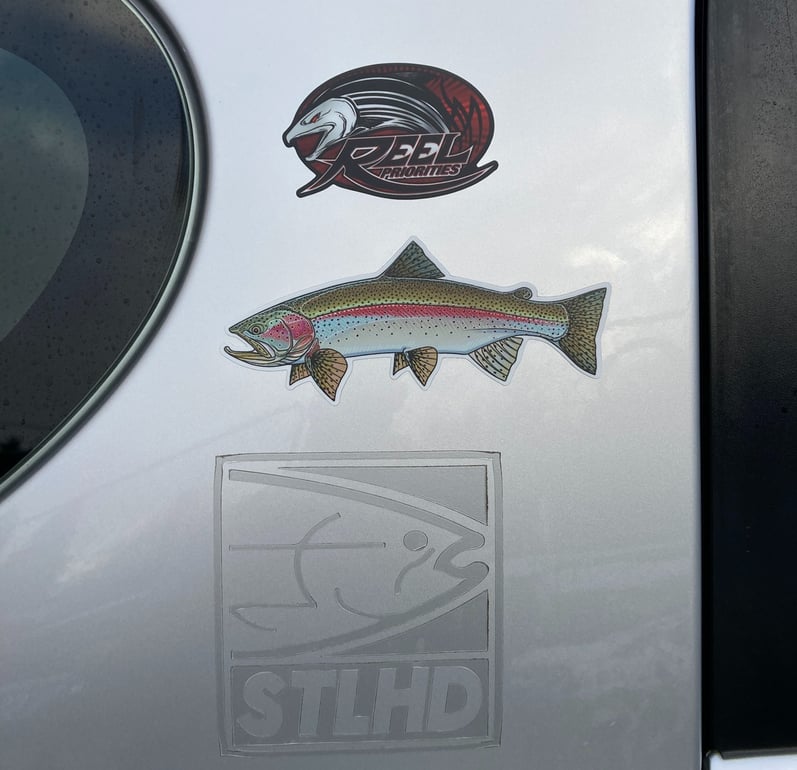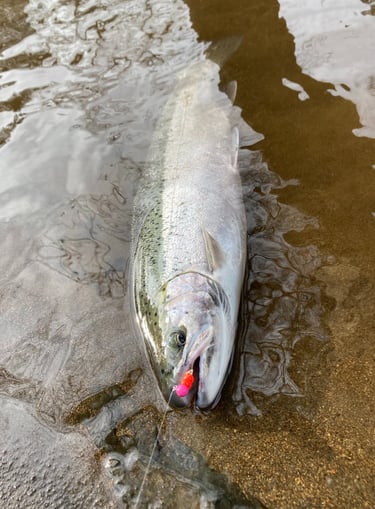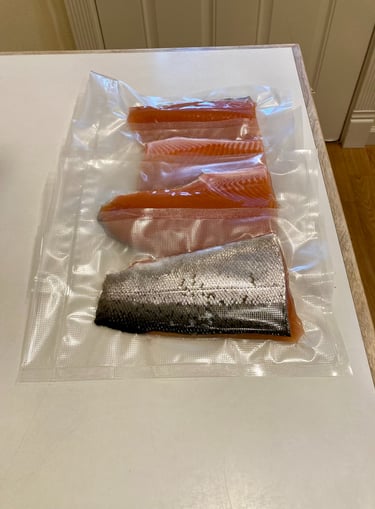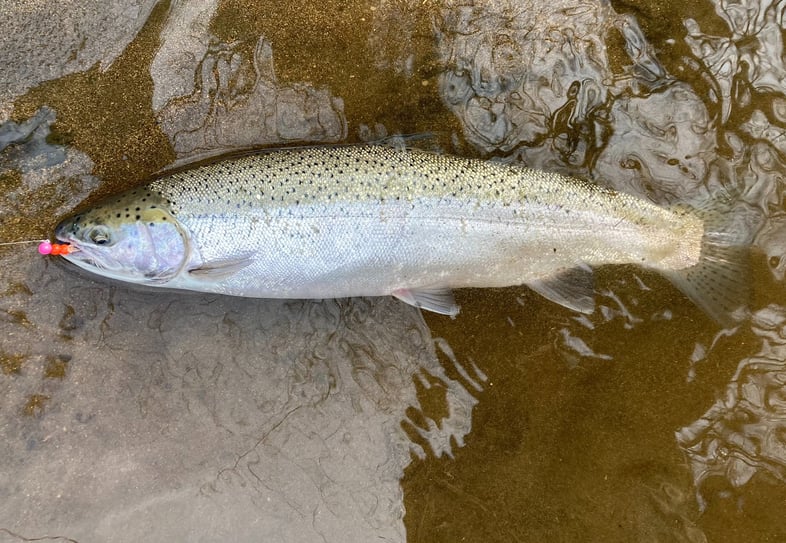Cork and Iron
A Small, Bright Fish
2/7/2025


It was white this morning, the bird song muffled by 3.15” of thick, sticky-damp snow that fell last night. I borrowed the neighbor’s red stemmed rock shovel with the splintered black plastic handle to clear the somewhat flat driveway — and the steep hill. What sucked the most was the thin sheet of ice cradled beneath the snow, which had the Captain's F-350 spinning triple axels yesterday morn; it even unnerved our litigious neighbor in his shiny red, 2500 Chevy truck, when he had to leave early for his farm a half hour out of town to water his laying hens. Quite soon it became apparent that the rock shovel was not the correct implement for the job of safeguarding my fellow man. With great suffering, I repurposed it for a makeshift snow-rake, loudly scraping the white fluff to the sides of 81% of the potholed, bumpy, gravel hill, and my swath of the black top. I started with each compressed tire track from the mysterious early morning descender, and worked that single track down to the snow barren spot protected by the alder boughs overhead, repeating the process on the other track going back up. The energetic cost was: two bananas, a liter of warm water fresh out of the distiller and an hour-and-a-half of earth time. Little did I know that later this day, my efforts would be rewarded. Mid-morning as nature retracted her dreadful bone chill, people began stirring about. Without a tire slipping everyone worried up and cruised down the hill without peril (including Fritz, our WWE-philic mailman who delivers the weekly paper, mostly when he remembers). Peeling back that few inches of fresh snow allowed the lukewarm afternoon rays to melt that nasty, stubborn layer of iced-gravel below. With my duty complete, I headed back for warmth and reprieve — for hearth and home. Once inside, I swapped out my sage green, sweat-soaked waffle shirt for a dry one. Clip fully loaded from the evening prior, I fired off another cartridge (job application to a local cannery), slammed a 14 oz jar of late-winter cutthroat we canned last April and balled up a half-sleeve of some day-old-stale unsalted saltines and quickly shoved them down my gullet. As I rushed out the door with one leg in my Simms waders and one hand on a bending stick for an hour of C&I (Cork and Iron) 12 minutes east on the road, April chased after me with my fingerless wool gloves for my pursuit of a small, bright fish (SBF) at the stream.
The main roads were clear and tawny by then. Small cars raced 45 mph past the 35 mph sign across from the McDonald’s, on the side of the street where the money laundering shell company sits, the one that organized crime calls a restaurant, eerily busy once-per-month. While it has an unusually high amount of fake Google reviews (damn the price of that tiny, tasteless, loathsome excuse they call a BLT) and somehow employs two full-time workers without any visible means of income, I'll say it seems like a neat place to hide said gem-of-a-vehicle. The locals say nothing because they a). don't know, b). don't care or c). all of the above. Then again, why cause problems where there are none? So long as the lights turn on, the elk backstraps stay cool in the fridge and the gears stay greased with them cans of fresh smoked steelhead passed along to the neighbors, all is right in the world.
Hermit Dan’s rig was ditched head long in the snow. The younger local men poke fun at him and call him Corolla, though he drives one jalopy of a metallic teal Camry from the early 90’s. It was brand new when that sweet grandma in Aberdeen sold it to him for a few grand just two years back, and even I marveled at the disheveled old hills boy’s unsettlingly clean and tidy sedan that emerged one day. Two years later after broadsiding a large truck tire and cheese grating a few guardrails near the Monte cutoff, it has now been successfully forged it into a rough figure resembling himself. Strange how the condition of folk’s belongings so often reflect the condition of their characters. I put in the extra effort with a 5-point-turn to park GK snout-out, so just in case that snow didn’t melt, I could slam it, rock it and squirm back into the road where all was safe and clean and dry — while hopefully not prematurely meeting Jesus per the mud-splotched grill of a Weyerhaeuser log truck whizzing by during the the ensemble.
So I strapped on my river chains and, with stick in-hand, crossed the snowy gully behind the guardrail, chugged up the hill and whisked down the path to the hole. Now there are four ways to get streamside: the first three pathways carve through the ferns beneath the large, dark oak looming on the left, if you don’t walk through the farmer’s patch, where the welded anchor chain table that Captain Calvin pondered borrowing — weighing 100 stone — still sits. The remains of the cracked satellite dish since that terrible wind storm three-some-odd years back, when that falling limb nearly ushered Captain Takahashi into the afterlife, still lay along the head of the path, too. While that way is far easier as a local to traverse (keep your distance, city boys), I walk the first path, because even though it makes you weave hard right, duck beneath the vine maple, pass through the middle path and then you got to lift your legs over that thick branch, it provides the wisest angle of descent down the jagged, eroding hillside. With the feet aimed properly towards the clumps of grass roots, it reduces (may prevent or reduce in severity) sliding and catching your feet much too late before going headlong into the slippery bedrock below and eating sh*t. I soon emerged from the young forest and began to slosh my way upstream.
As I peered above, I noticed my star student, Spooner, swinging the head of the faster riffle above, in the next slot called Interim. I figured he’d already banked the double-banded, double-digit beast-of-a-buck that had been lurking somewheres in the deep, soupy-green depths where you can’t see because it’s just too ruffled at the surface, but I wasn’t worried because VLF (very large fish) are no longer my quarry. I've got a deeply set barbless hook in my maw for SBF, without that adipose fin, the one that lets me take 'em home for supper when it’s gone, and keeps my wife happy and her larder bursting at the seams. I began working it with 4’ of light fluorocarbon leader and AJ’s jig, a 1/16th oz white head jig, with an orange-and-flame-red tail. Bundled with two symmetrical strips of Krystal Flash, it's my rendition of a deadly salmon pattern taught to me by my mentor and 55 year master, the old German legend who took me under his wing the first summer he found me bobbling around out here, Mr. Heitmann. He's the only one I've seen walk down the hill at Crusher, bang out two long, 20# B-run silvers within three-or-four short casts, and head back up the hill to his truck with 40# of fresh kill, faster than you can say West Virginia. Since my float speed was perfect and the water was somewhat green-clear, I worked the slot from the bottom and casted up, lest I betrayed my presence and spooked a wary, traveling fish. When you cast up and a fish rises, the hook beneath the cork floats towards you, and you get a real quality hook set which increases your chances of banking your opponent. With barbless hooks, no bait and no scent, an angler must consider every angle and deploy every method to his advantage to consistently succeed. While most people think barbed hooks are best, barbless hooks are far better, because if you don’t slack out your line while playing your fish, that hook continues to cut into the jaw and deeply imbeds itself into the hard cartilage, making it immovable and unshakable. It can also pierce neatly through the nose or corner of the mouth, much like the nose studs and lip rings that those blue-haired baboons commonly sport down in Eugene, Oregon, the place where nobody ever knew a cooking prodigy and Japanese transplant would open up shop and sell mouth-melting gyoza with your ramen; portions of my prefrontal cortex still flicker after being short circuited by such good food. After I flogged the slot to the head without a reply, I cinched down the drag on my small spinning reel, winded on a 1/4 oz candy blue teardrop spoon and commenced working the slot back down. Midway through the sweet spot where the big ones like to sit, I felt a fuzzy wobble-and-head-shake, but no connection. I figured it was the one Spooner must’ve caught because sometimes a hook-stung or played fish will peck out a low quality bite, when the best of their curiosity takes over. I kept on probing and worked myself down through the next slot, a faster moving and somewhat shallow, level flat, with narrow chutes carved into the granite, where the fish gotta suck it in and swim through like straws after shooting the rapids, again without reply.
As I traipsed my way back up to the hole, I tied on a 1/16th oz Winter Workhorse to begin my surgical session and pick apart the remaining water. A quarter of the way beneath the heaviest current of the run, I long casted my water-darkened cork float, little pink and white jig sailing faithfully behind, and carefully traced the seam by the rock shelf, the seam running beneath the last patch of weeping, snow-burned grass that so frequently hides the chargers cruising on up. Time stopped as my cork blipped into oblivion: I quickly lifted my rod and nailed the tacky-sharp jig hook into the top of the ghost’s hard mouth: fish on! He immediately sprinted the entire length of the slot downstream. No sooner had he reached the bottom end when my line began losing tension, causing me to reel as frantically fast as my tiny Shimano 1000 reel could take, to keep steady-and-even pressure on that barb-shaven-hook. He floored it upstream for the next run, like a rich kid in dad’s red 2024 Corvette, tires squealing, hell bent on impressing the broads about after the Friday night football game. No sooner than his nostril flared against the broken water and fast current, he bolted to the surface and went aerial, head raised high, tail fin motoring pedal-to-the-steel as he shook mightily like a migrating Red salmon, defying the line of Grizzlies that effortlessly swat them down like gnats circling a mid-afternoon picnic watermelon. After a second jump in the other direction, he nosed down and dove deep, playing like the big fish do, size conspicuously betrayed by his youthful acrobatics early on. Five minutes later in the back-and-forth and he was finning over to the frog water, now doggie-tailing as fatigue began to lock his rudder. I immediately lightened my drag as I saw that last spark of defiance flash in the black apple of his right eye and he made one final see-saw run towards the center, turned down, and violently shook his head twenty-three-and-a-quarter times during one full rotation in his submarine cartwheel. Discouraged, spent and still undeniably hooked, he begrudgingly let me lead him through the slack water, across the wads of submerged canary grass, and into the 5” water above the bedrock speckled with fine grains of light tan sand. With his final grams of strength he let loose with one 1960’s station-wagon-wide grocery parking lot turn, his final slow jog for freedom. I gently redirected his teenage angst for the calm water and slid him gingerly onto the shallow bank: victory! In all of the shining glory of his 19” defiance spent, this young stud buck was the finest fish I had played all season, brutes, longs, B-run and cutthroat considered. As in life and with fighting, it’s never the size that determines the fight, but the stoutness of heart that decides the outcome, time-and-again. I held him fast as the blood left his body, and he slowly passed into the afterlife, allowing the silken sheets of darkness to overtake him, hook still deeply lodged in his snout, lest his posthumous tremors propel his chainmail-silver body back into the abyss, to be lost forever.
And that was an afternoon at the place where the stream meets the great beyond, where you get to take one last cast before crossing into the bright light at the end of the tunnel.







